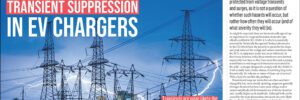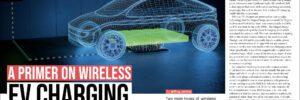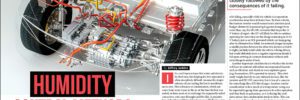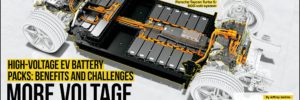
Anything powered by an external source of electricity needs to be protected from voltage transients and surges, as it is not a question of whether such hazards will occur, but rather how often they will occur (and of what severity they will be). As might be expected, there are internationally agreed-upon regulations for surge and… Read more »
Author: Jeffrey Jenkins
How to improve EV traction motor efficiency

A look at improving motor efficiency in two main categories: electrical and mechanical. Regular readers of Charged don’t need to be told that the typical EV drivetrain is way more efficient from battery to wheels than its ICE-based equivalent, but it is perhaps less well-known that the approximate drivetrain efficiency ranges from 75-90% for the… Read more »
A primer on wireless EV charging technology

Two main types of wireless power transfer systems are being pursued these days: the inductive type, which is magnetically coupled, and resonantly-coupled systems using electromagnetic fields. The instant availability of maximum torque makes driving even the most economy-oriented EV way more fun than its ICE counterpart, but few would hold the same opinion about the… Read more »
Alternatives to permanent magnet motors in EV traction applications

In my very first article for Charged over 10 years ago, I opined that the Switched Reluctance Motor, or SRM, would eventually come to dominate the EV traction market, if for no other reason than the fact that it is almost as cheap as dirt to manufacture. I won’t sprain my shoulder patting myself on… Read more »
A closer look at high-power interconnects and disconnects

In the electrical/electronic world, the terms interconnect and disconnect both refer to a means of joining two sides of a circuit together. The subtle—and entirely informal—difference is that an interconnect is directly or manually operated (inserting a plug into a jack, for example) while a disconnect is indirectly or automatically operated, for example the moving… Read more »
A closer look at why heat pumps are dominating EV HVAC systems

Heating or cooling the interior cabin of an EV substantially affects the vehicle’s on-road efficiency, and the HVAC system often gets the proverbial “rented mule” treatment. In an ICE vehicle—particularly an underpowered one—there is a visceral reminder that running the AC, at least, costs something, since there is a palpable hit to acceleration whenever the… Read more »
A closer look at humidity control methods for EV electronics

It’s a well-known trope that water and electricity don’t mix, but keeping the two separated is often deceptively difficult, because the simple solution of just sealing the box is insufficient on its own. This is because of condensation, which can come from water vapor in the air at the time the box was sealed, or… Read more »
A closer look at axial flux motors

In Issue 49, we reviewed some of the more promising advancements in materials and construction techniques for EV traction motors, one of which—the axial flux design—will be the focus of this article. Despite being characterized as an advanced construction technique, the axial flux design is actually one of the oldest ways of constructing a motor—it’s… Read more »
High-voltage EV battery packs: benefits and challenges. More voltage, more better?

In 2020, Porsche delivered just over 20,000 units of its luxury Taycan EV—the first vehicle from a major automaker to sport an 800 V (nominal) battery, which is more than double the voltage of its competitors (and firmly into light-rail and switchyard locomotive territory, actually). It appears that many other EVs will soon follow in… Read more »
Isolation technologies for EV power electronics

A previous article on bidirectional chargers [see our July/August 2020 issue] touched on using transformers to provide isolation at high power levels—in which application they are the only game in town, really—but this time the focus will be on achieving isolation at low power levels, such as the feedback signal in a regulator, data communication… Read more »
